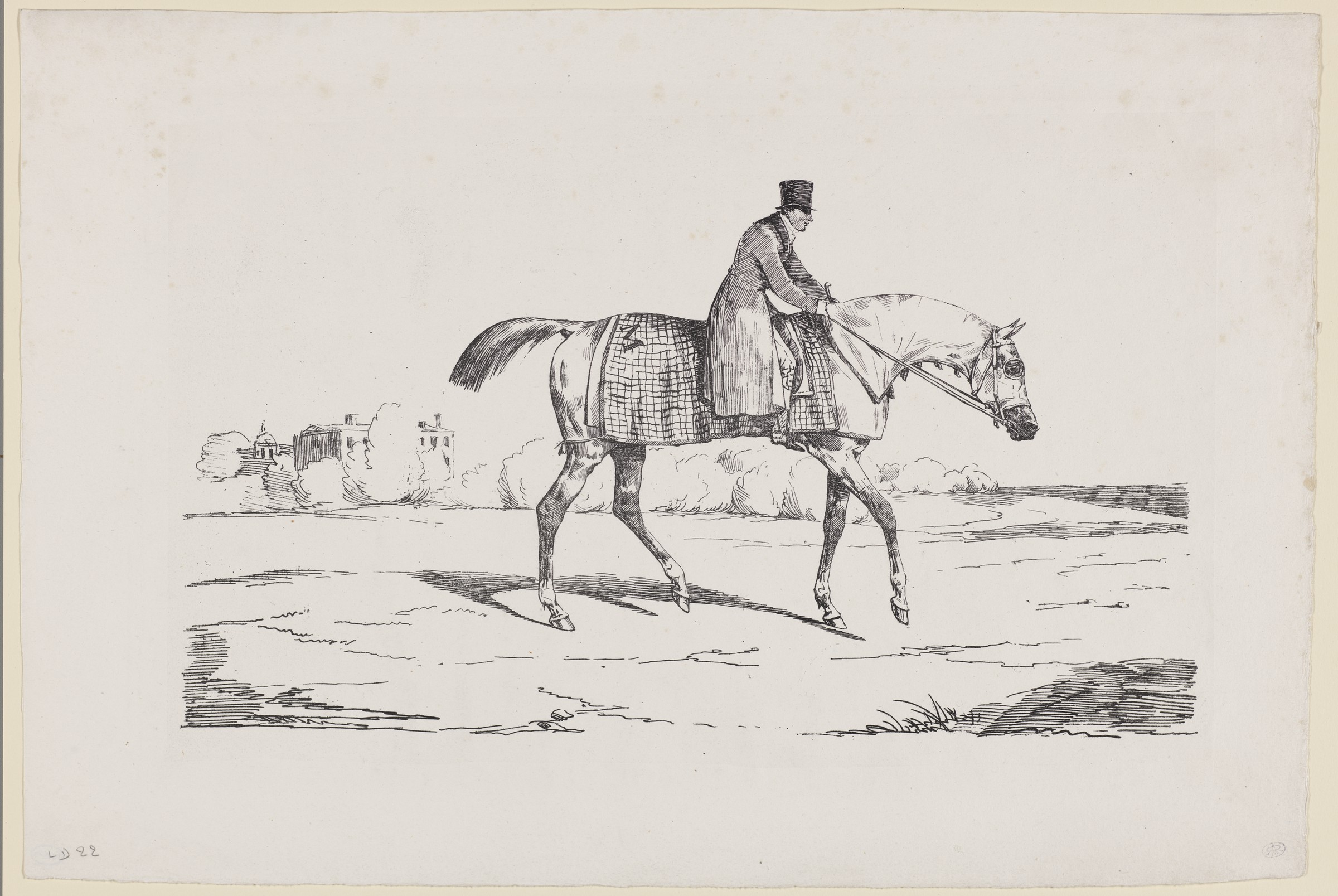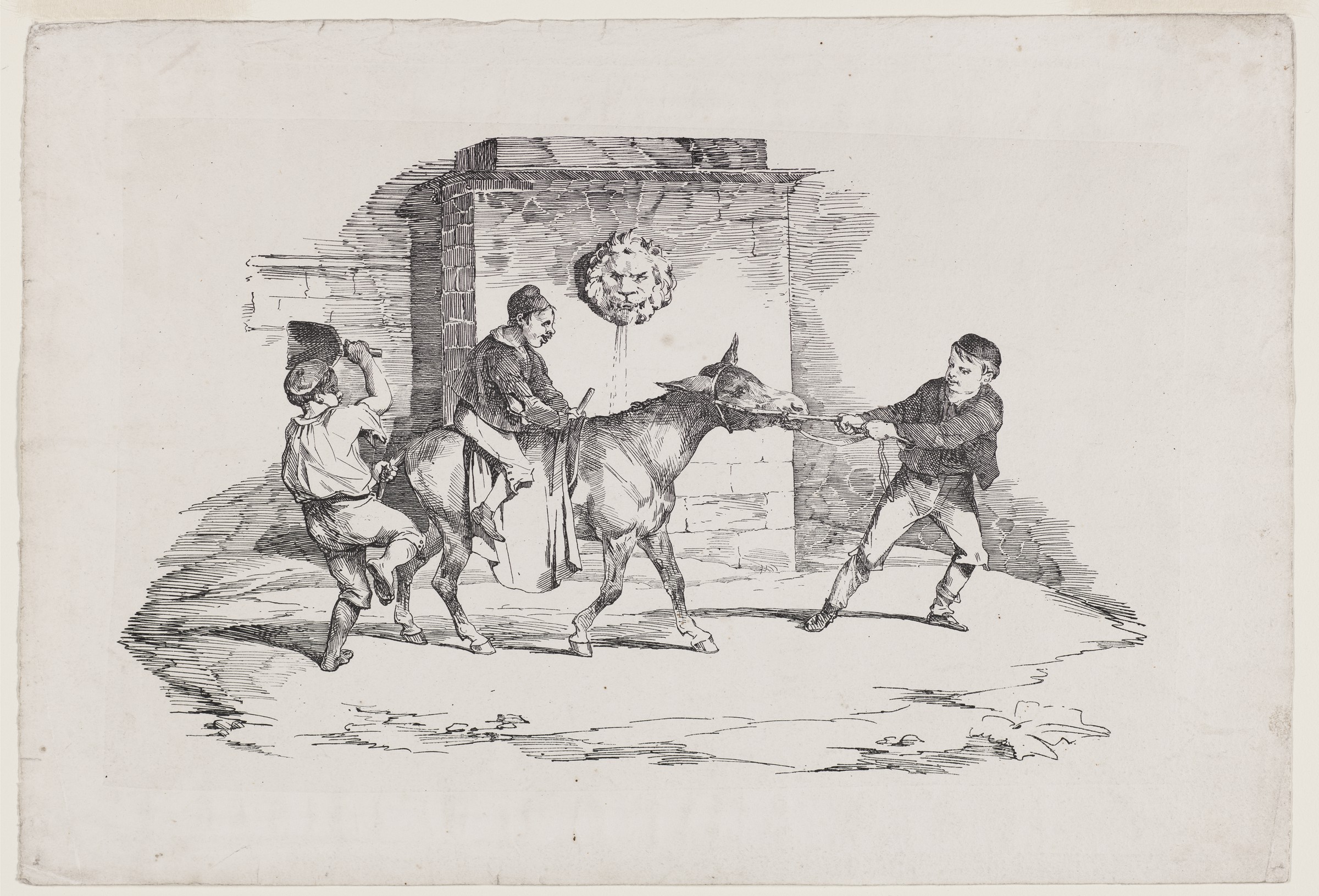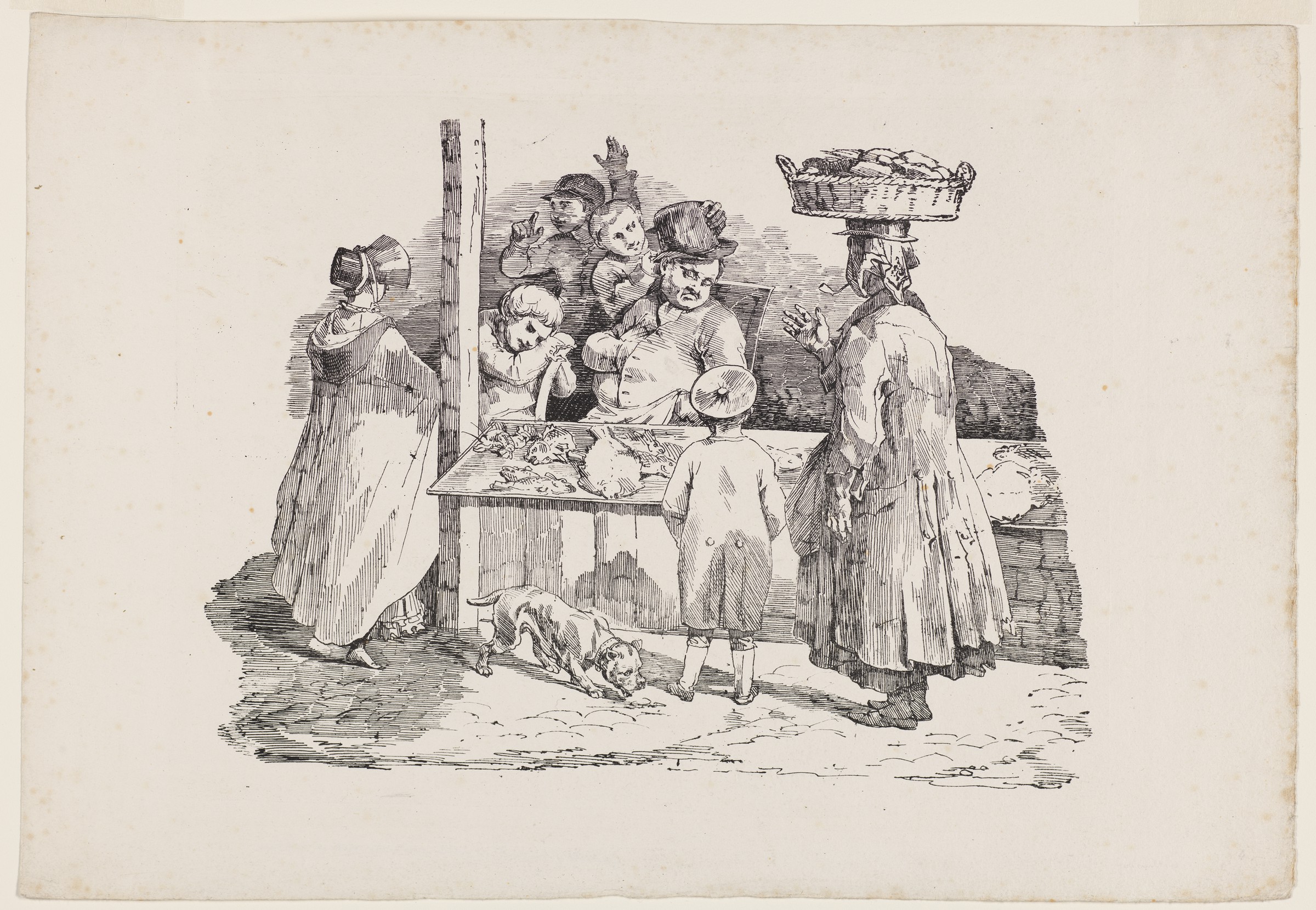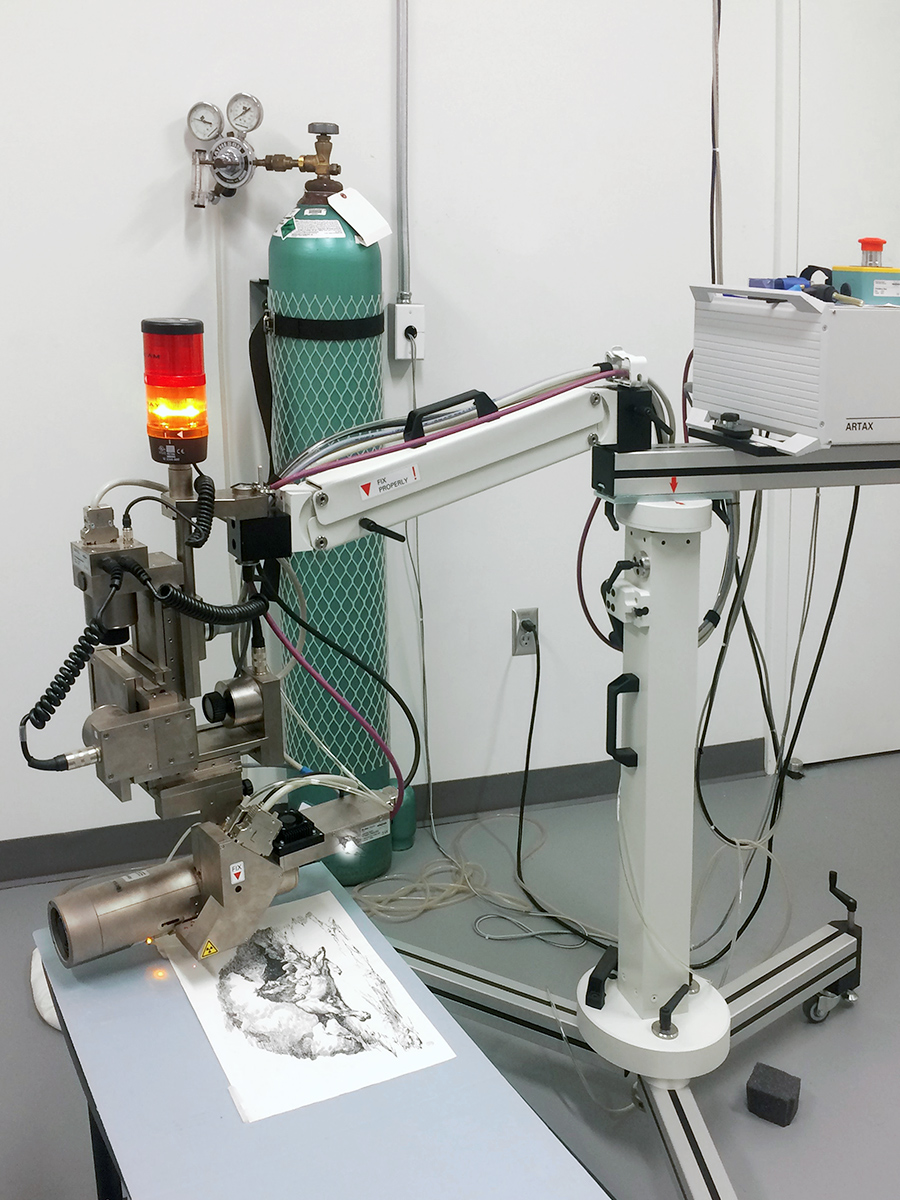The exhibition Mutiny: Works by Géricault features a rare and unusual object in the collections of the Harvard Art Museums: an example of the French Romantic artist’s stone paper, an alternative lithographic printing matrix he used to make the work Lion Devouring a Horse.
Géricault’s “Stone Paper”
The use of stone paper as a matrix (or printing surface) for lithographic printing, instead of traditional limestone, was an experiment for Géricault. He made a series of seven stone paper prints between 1820 and 1821; the Harvard Art Museums have four examples from this series. (See all four in the slideshow below.) Although there is no record of other artists having used stone paper, it is likely that others explored the technique in their work as well.
Along with colleagues in the Straus Center for Conservation and Technical Studies, I recently examined these prints, the lithographic printing matrix for Lion Devouring a Horse, and Géricault’s own lithographic printing practice in hopes of better understanding both the technique and Géricault’s short-lived use of it.
Before I describe my analysis, let’s review a few terms and techniques:
What is a printing matrix?
A printing matrix is the substrate from which ink is transferred to paper during printing. Common printing matrices are wood blocks (for woodcuts), copper plates (for etchings and engravings), and limestone (for lithographs). A common feature of printmaking is that multiple prints can be “pulled” from one printing matrix.
What is lithography?
Invented in 1798 by Alois Senefelder, lithography is a printing process that relies on the chemical properties of oil and water, which repel each other. Although the most common printing matrix for lithography is limestone, it’s possible to print lithographically from many different supports, ranging from metal and plastic to wood and paper.
The most common forms of lithography use a water film in the non-printing areas and an oil-based ink in the printing areas. The image is drawn on the prepared matrix with a greasy material. Once the drawing is complete, the surface is processed and wetted for printing. Oil-based ink is rolled over the entire surface and is repelled by the water in the non-image areas and attracted to the greasy drawing. Paper is placed over the image and run through a printing press to transfer the greasy ink to the paper to create the print. This process is repeated until the desired number of impressions has been reached.
What is stone paper?
Stone paper is a bit of a misnomer. It is a lithographic printing matrix made of a heavyweight paper that has been prepared with a special coating, produced to replicate properties of limestone. Like other lithographic processes, the image is drawn on the prepared surface with a greasy material and the surface is then processed and printed from. Artists began experimenting with stone paper in the early 19th century. It was advertised as an excellent alternative to limestone for several reasons:
- The limestone suitable for lithography was mined from quarries in Bavaria, forcing printmakers in other countries to import the stone. Avoiding the expense of shipping and importation was a key motivation for these countries to find an alternative that could be sourced or manufactured anywhere.
- Limestone was extremely heavy and difficult to manage. Since stone paper is lightweight (it is only a sheet of paper), it was easily transported. Artists could work on their drawings outside the studio and easily carry stone papers.
- Stone paper was much less expensive than the limestone alternative, and printing stone paper didn’t require as much chemical processing. It could be printed by an amateur, therefore extending the reach of lithography to the masses.
Unfortunately, these benefits could not outweigh the difficulties this material presented during printing, and Géricault, like others using the medium at the time, abandoned it after some experimentation. The stone paper coating proved not stable enough, breaking down during printing. And while limestone could be printed up to one thousand times consistently, stone paper could produce up to only 20 impressions. Because stone paper was in use for such a short period of time, very little is known about it—and even less is known about Géricault’s stone paper. Our team in the Straus Center was eager to investigate.
Technical Analysis
To better understand the materials and components of Géricault’s stone paper, associate conservation scientist Georgina Rayner and Katherine Eremin, the Patricia Cornwell Senior Conservation Scientist, undertook chemical analysis in several phases. X-ray fluorescence (XRF), a non-invasive technique used to identify inorganic compounds, showed the presence of lead. We were expecting to see evidence of calcium, because calcium carbonate (chalk) was in all historical stone paper recipes, but no calcium was detected in our stone paper coating.
Fourier transform infrared spectroscopy (FTIR), a tool used to determine a variety of materials, confirmed the lead as lead white, as well as the presence of oil, gum, and what was possibly a protein. Matrix-assisted laser desorption/ionization time-of-flight (MALDI-TOF), an excellent tool for identifying proteins, revealed the possible protein from the FTIR analysis as casein, a milk protein used to make casein glues. This was an exciting discovery because it was unexpected (and nearly went undetected).
Overall, the analysis told us that the composition of the stone paper coating was a mixture of lead white, oil, gum, and casein—an interesting finding because this composition does not match any of the existing recipes documented in historical literature. These components were likely mixed together and applied to the paper support with a brush.
For the next step in our investigation, printmaker Christopher Wallace and I made a series of mock-ups to better understand how the material works. Knowing the composition of the coating from the analysis provided us with a great starting point. We hoped to discover why the coating deteriorated and what role each component played.
We made a series of samples (around 30 in total), with each containing lead white as the pigment or base. We modified the binder component for each (most were combinations of oil, casein, and gum). The coatings were all brushed out onto papers that were a comparable thickness to the stone paper. We then used a greasy ink to replicate Géricault’s mark making style as best we could.
Creating and printing the mock-ups revealed that casein was likely added to stabilize the non-image areas and that the oil was added to strengthen the image. It also became clear that stone paper was very sensitive and difficult to print. Even the samples with the best ratios of components were very inconsistent—an undesirable characteristic for printing. This inconsistency is likely something that Géricault and his printer struggled with when making their series of prints.
The combination of historical research, close looking, scientific analysis, and artistic re-creations allowed us to understand and contextualize this object in new and exciting ways. At the time that Géricault was working, during the Industrial Revolution, Europe was experiencing unprecedented economic transformation, and the idea of being an innovator or inventor was highly regarded. Understanding stone paper is important not only to fill a small gap in the history of lithography and printmaking, but also to better understand Géricault’s unique motivations as an artist and an innovator.
If you want to learn more, be sure to attend Christina Taylor's gallery talk on Géricault's stone paper prints on Thursday, November 8, at 12:30pm.
Christina Taylor is assistant paper conservator in the Straus Center for Conservation and Technical Studies at the Harvard Art Museums.










